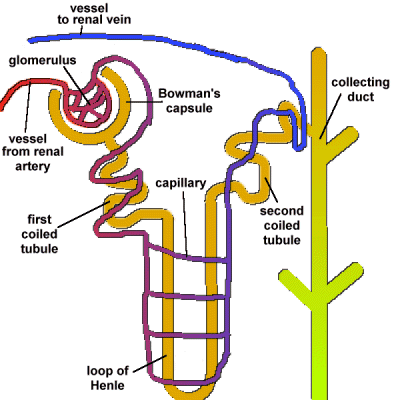Each human kidney is made up of about ten lakh excretory units called nephrons. A nephron is a long, narrow and twisted tubular structure. The upper end of the nephron is a cup shaped bag and it is called Bowman’s capsule. The lower end of the nephron is tube shaped and is called tubule. The Bowman’s capsule possesses a bundle of blood capillaries called glomerulus. The blood capillaries bring the dirty blood containing urea and excess water from renal artery.

During the passage of dirty blood through glomeruler capillaries, the small molecules of urea, glucose, amino acids, salts and water etc. present in the blood are passed into Bowman’s capsule as filtrate. Thus, the function of glomerulus is to filter the blood passing through it. The filtrate present in the Bowman’s capsule is then passed through the tubular part of the nephron. As the filtrate passes through the tubular part of the nephron, the useful substances such as glucose, amino acids, salts and water are reabsorbed by the blood capillaries surrounding the nephron and only the waste substances such as urea, some salts and excess water remain behind in the tubule. Finally, the waste materials present in the tubule (also called urine) is passed to the urinary bladder through the collecting ducts
Test Your Understanding and Answer These Questions:
- What is nephron? Explain its structure.
- What is glomerulus? What is its function?
- Give differences between nephron and nephridium.
- Briefly describe the mechanism of urine formation.
- What happens to glucose which enters the nephron along with the filtrate?
- Which is the major nitrogenous waste product in a human being? How is it removed from the body?
